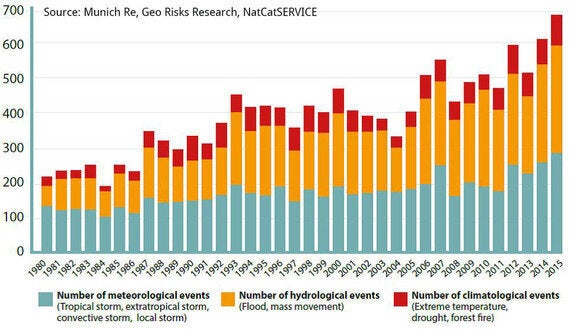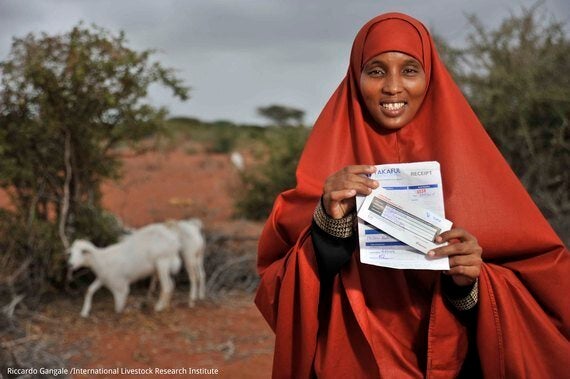Leaders meeting at the World Humanitarian Summit could transform the way we respond to the increasingly severe disasters caused by climate change. Here's how.
Last month was the hottest April on record globally, by a massive margin - the seventh month in a row to smash the global temperature record. 2015 was our planet's hottest year on record. Right now, a number of countries - Ethiopia, as well as Malawi, Zambia and Zimbabwe - are at crisis point, facing a severity of drought not seen for decades. At the same time, hundreds of millions of people across India are in the grip of unprecedented heatwaves, droughts and floods. Recently, Cyclone Winston wreaked devastation on the island of Fiji and wiped 10% off its GDP: it was the worst storm ever recorded in the southern hemisphere. These are not anomalies: they are just a few examples of a trend. Extreme weather events occurred twice as frequently during the past decade as they did in the period 1985-94.

In this 'new normal' of climate crisis, it is the world's poorest and most vulnerable communities who are on the front lines. People whose livelihoods depend on predictable weather patterns, such as smallholders and pastoralists are especially vulnerable. One drought, one typhoon, or one failed crop can wipe out years of hard work.
This is why, earlier in my career, I was involved in a project that provided typhoon insurance to smallholder farmers in the Philippines. By plotting otherwise unregistered farm locations with GPS, then checking how closely a typhoon passed and its severity, we were able to provide farmers with insurance that provided them security and peace of mind. That groundbreaking project has been just one of many similar projects carried out around the world for all kinds of risks in all kinds of environments, collectively creating the evidence base we need to take this kind of protection to scale.
That is timely. On Monday the 23rd of May, world leaders are gathering in Istanbul for the World Humanitarian Summit. One of the main priorities of the Summit is shifting the way we deal with climate shocks and disasters from laborious and often slow-moving international aid appeals to equipping governments and local communities with the tools and resources they need to actively prepare and build resilience beforehand.
As RESULTS UK's new report Weathering a Risky Climate shows, microinsurance that directly protects vulnerable households is one of the tools that can help drive this shift. New and emerging kinds of climate risk microinsurance schemes, known as "index" or "parametric" insurance, are linked to specific weather conditions.

For example, satellite and weather station data is monitored to assess whether the amount of rain in a certain area has fallen below a pre-defined threshold over a certain period of time, such as a critical window in the agricultural growing season. If the threshold is breached, an insurance payout is triggered automatically. This hugely lowers the cost of administering the insurance scheme, and has made the provision of weather-related insurance viable for low-income households on a massive scale.
Without insurance or other forms of support, vulnerable people who have lost their crops or seen their business wrecked are often forced to resort to survival strategies that can have devastating long-term consequences, such as spiralling into debt, selling off animals or belongings, skipping meals, or pulling children out of school. A rapid insurance payout can prevent this from happening.
In Kenya, pastoralist households with access to index-based livestock insurance were 36% less likely to sell off their remaining livestock and 25% less likely to reduce meals as a coping strategy during the 2011 drought. In Senegal, poor farmers enrolled in the 'R4 Rural Resilience Initiative' (an Oxfam America and World Food Programme partnership that integrates microinsurance with savings, credit, natural resource management and livelihoods initiatives) maintained their level of food security during the recent El Niño cycle compared to uninsured farmers in the same area. R4 farmers in Ethiopia save more than twice than those without insurance, and invest more in seeds and fertiliser.
Insurance is not a silver bullet. It cannot be used to address many climate perils such as sea-level rise, desertification and ocean acidification. It cannot be used to protect against extreme weather events that occur more frequently than, roughly, once in five years - and climate change is increasing the number and impact of such extensive shocks on communities. And it cannot necessarily be used to protect against the most catastrophic events, whose impacts are literally off the charts: even the global insurance industry is reluctant to take on these kinds of risks.
In order for it to work, we have to treat insurance as just one piece of a much bigger climate risk management puzzle, not as a standalone solution. This means that public investments in risk financing should not replace - but can bolster and complement - investments in disaster risk reduction, climate adaptation, and social protection.
Nevertheless, insurance is currently a vastly under-used tool in the toolkit. Uninsured weather-related losses in developing countries averaged $8.1 billion per year over the past decade. Only 10% of smallholder farmers worldwide have access to any form of agricultural insurance. And just 100 million people across the entire populations of Africa, Asia and Latin America are estimated to be covered by climate risk insurance specifically. Only a small portion of these are covered directly by microinsurance.
Political momentum on this issue is growing. Some 15 developing countries - from India to Kenya to Ethiopia - are rolling out weather-based insurance programmes that target vulnerable individuals directly. But strong donor assistance is needed to ensure that these schemes can properly support the poorest people, including financial support to pay the premiums of those who cannot afford them.
Last year, the G7 launched a new initiative called 'InsuResilience', which aims to expand climate insurance coverage to an additional 400 million people by 2020. The G7's goals are laudable but in order to achieve them, donors will need to think beyond just building commercial markets. We know that insurance products at commercial prices will always be out of reach for the poorest people.
In our report, RESULTS UK proposes new 'Pro-Poor Principles for Climate Risk Insurance' that we want to see donors adopt as a 'gold standard' for their investments in this area. They cover a number of different issues, but among them is the need to guarantee accessibility for the poor. By committing to target the most marginalised and vulnerable people, including through financial support to pay their premiums, donors can ensure that climate risk insurance programmes leave no-one behind.
As leaders arrive in Istanbul for the World Humanitarian Summit, they should recognise and champion the role of microinsurance to help protect the poor from growing climate risks and agree to invest more funding into such programmes. But unless they also take a principled approach and commit to invest long-term funding in a way that truly builds resilience for the poorest people, they will fail to realise the potential of climate risk insurance to reduce poverty for hundreds of millions of people.
